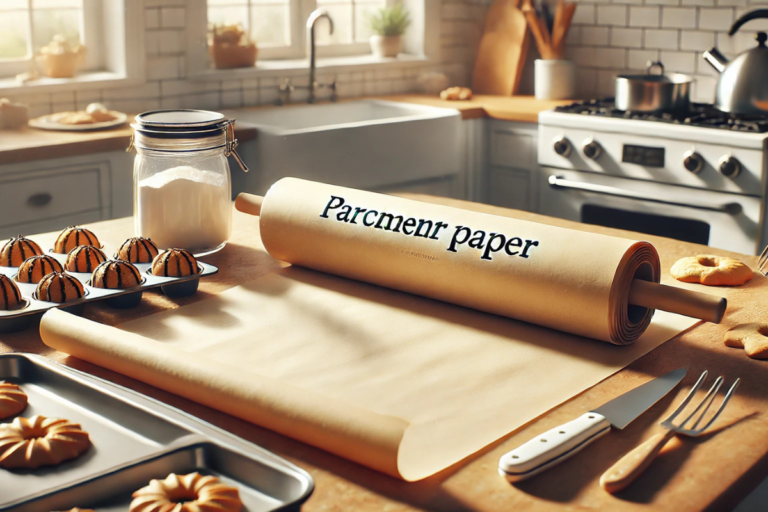Introduction to Parchment Paper
What is Parchment Paper?
Parchment paper is a versatile kitchen tool. It’s a thin, non-stick paper that’s heat-resistant. Chefs, bakers, and home cooks use it for baking, cooking, and even steaming. It prevents food from sticking to baking sheets and pans. This makes clean-up quick and easy. Parchment paper is coated with silicone, which gives it its non-stick property. You can find it in rolls or pre-cut sheets, and it is often available in two types: bleached (white) and unbleached (brown).
Brief History and Origin of Parchment Paper
The origins of parchment paper trace back to ancient times. It was first made from animal skins. This material was popular for writing in ancient Greece and Rome. But today’s parchment paper for cooking is different. It’s made from cellulose fibers and treated with silicone to withstand heat. Over time, its use has expanded from just baking to include roasting, steaming, and other culinary techniques.
Why is Parchment Paper Popular in Cooking and Baking?
Parchment paper is popular because it’s convenient and effective. It is non-stick, so baked goods like cookies and cakes slide off easily. It also helps food cook evenly by distributing heat well. Many bakers use it to line cake pans, ensuring that cakes come out intact. For cooking, it’s great for wrapping fish or vegetables before baking. It keeps moisture in, making food tender. Parchment paper also reduces the need for extra oil, making dishes healthier.
Uses Beyond Cooking: Crafting, Art, and Packaging
Parchment paper isn’t just for the kitchen. It’s useful for other activities too. Many people use it for arts and crafts. It’s excellent for protecting surfaces when painting or drawing. Artists use it for layering colors in mixed media projects. It is also popular for packaging homemade gifts like cookies or candies. The paper is durable, making it a reliable choice for wrapping. Some even use it to preserve documents or for tracing patterns.
What is Parchment Paper Made Of?
Composition and Materials Used
Parchment paper is made from cellulose, a natural fiber found in plants. It goes through a process that makes it strong, heat-resistant, and non-stick. The key feature is its silicone coating, which gives it its non-stick surface. Silicone makes it resistant to moisture and high heat, making it perfect for baking and cooking. This coating also prevents grease from seeping through, keeping food and surfaces clean.
Difference Between Parchment Paper and Wax Paper
Many people confuse parchment paper with wax paper, but they are different. Parchment paper is heat-resistant because of its silicone coating. It can be safely used in ovens and microwaves. Wax paper, on the other hand, is coated with wax. It is not heat-resistant, so it can melt or catch fire in the oven. Wax paper is best for wrapping food or keeping surfaces clean when working with dough, but it should not be used for baking.
How is Parchment Paper Manufactured?
The production of parchment paper begins with wood pulp, which is treated to create cellulose fibers. These fibers are processed into thin sheets. Next, they are coated with silicone on both sides. This coating ensures the paper’s non-stick, moisture-resistant properties. It’s then cut into rolls or sheets and packed for sale. The manufacturing process ensures that the paper is food-safe, durable, and versatile.
Types of Parchment Paper
Unbleached Parchment Paper: Eco-Friendly Option
Unbleached parchment paper is brown and natural-looking. It’s made without chlorine, making it an eco-friendly choice. It has the same non-stick and heat-resistant properties as regular parchment paper. Many people prefer unbleached parchment because it is considered safer and more environmentally friendly. It is ideal for baking, roasting, and even wrapping sandwiches or snacks.
Bleached Parchment Paper: Popular and Widely Used
Bleached parchment paper is white because it undergoes a chlorine-based process to remove its natural brown color. This type of parchment is more common in kitchens and is often used for baking cookies, lining cake pans, or roasting vegetables. While it has the same non-stick qualities as unbleached paper, some people avoid it due to the bleaching process. Both types of parchment paper work well for most cooking tasks.
Pre-Cut Sheets vs. Rolls: Which is Better?
Parchment paper is available in two forms: pre-cut sheets and rolls. Pre-cut sheets are convenient because they are ready to use. They fit most baking sheets, saving you time. Rolls are more flexible; you can cut them to any size you need. Some prefer rolls for bigger baking projects or when lining large pans. The choice depends on personal preference and the task at hand.
Benefits of Using Parchment Paper
Non-Stick Surface: Ensuring Easy Cleanup
Parchment paper has a non-stick coating that makes baking and cooking easier. Food doesn’t stick to it, so cookies, cakes, and other baked items come off cleanly. This also means less scrubbing for you. Whether you are making cookies, roasting vegetables, or baking bread, parchment paper keeps your baking sheets and pans cleaner.
Even Baking and Cooking: Prevents Burning
Parchment paper helps distribute heat evenly. It prevents direct contact with metal pans, reducing the risk of burning or over-browning. It’s great for getting that golden brown color without burning the bottom. This feature makes it ideal for cookies, cakes, and even roasting vegetables.
Health Benefits: Reducing the Need for Oils or Fats
Using parchment paper allows you to cook with less oil. Because of its non-stick surface, you don’t need to grease pans. This makes your meals healthier since it reduces extra fats or oils. It is especially useful for low-fat baking and for cooking lean meats or fish.
High-Temperature Resistance: Safe for Ovens
Parchment paper is safe to use in the oven. It can handle temperatures up to 450°F (230°C), making it suitable for most baking and roasting needs. However, it’s always best to check the packaging for specific heat limits to avoid burning or browning the paper.
How to Use Parchment Paper for Cooking and Baking?
Lining Baking Sheets and Cake Pans
Parchment paper is commonly used to line baking sheets and cake pans. It prevents baked goods from sticking and makes removing them easier. It also helps cakes slide out of the pan smoothly, preventing breakage.
Wrapping Food for Steaming or Roasting
Parchment paper can be used to wrap fish, vegetables, or chicken for steaming. This cooking method locks in moisture, flavor, and nutrients. For roasting, wrapping food in parchment paper creates a tender, juicy dish.
Baking Crispy Foods Like Fries or Chicken Wings
Parchment paper is great for baking crispy foods. Whether it’s fries, chicken wings, or roasted veggies, it helps achieve a crispy texture. It allows heat to circulate evenly, making foods crunchy without sticking to the pan.
Parchment Paper for Dough Rolling and Cookie Baking
When working with dough, use parchment paper to prevent sticking. Place dough between two sheets of parchment and roll it out easily. It is also perfect for baking cookies, as it ensures even baking and prevents breakage when removing them from the baking sheet.
Using Parchment Paper in Air Fryers
Parchment paper is useful in air fryers too. It helps prevent food from sticking to the basket and makes cleanup easier. Make sure to use perforated parchment paper designed for air fryers, as this allows proper airflow.
Is Parchment Paper Safe for Cooking?
Temperature Limits: How Hot Can Parchment Paper Get?
Parchment paper can typically withstand temperatures up to 450°F (230°C). It should not be used for broiling or at temperatures higher than its limit, as it can turn brown and become brittle. Always check the packaging for specific heat ratings.
Is Parchment Paper Toxic? Safety Considerations
Parchment paper is non-toxic and food-safe when used correctly. The silicone coating is free from harmful chemicals. It’s safe for cooking, baking, and even microwave use. However, avoid using it at high temperatures to prevent any risk of burning.
Best Practices for Using Parchment Paper Safely
To use parchment paper safely, avoid exposing it directly to an oven’s heating element. Don’t use it for broiling or grilling. Always ensure that it lies flat on the baking sheet or pan. If it starts to curl or move, use oven-safe weights like metal utensils to keep it in place.
Alternatives to Parchment Paper
Silicone Baking Mats: Reusable and Non-Stick
Silicone baking mats are a popular alternative. They are reusable, non-stick, and easy to clean. They work well for baking cookies, pastries, and roasting vegetables. While they are more expensive upfront, they last longer than parchment paper.
Aluminum Foil: When to Use It Instead of Parchment Paper
Aluminum foil is heat-resistant and can be used for roasting, baking, or grilling. It’s useful for wrapping food but lacks the non-stick property of parchment paper. It’s also not recommended for lining cake pans, as it can stick to baked goods.
Wax Paper: Uses and Limitations
Wax paper has a wax coating that makes it non-stick and moisture-resistant. It’s good for wrapping food or lining counters, but it’s not heat-resistant. It should not be used in ovens, as the wax can melt and cause smoke or fire.
Natural Leaves (e.g., Banana Leaves) as Natural Wraps
Banana leaves and other natural wraps are a traditional alternative. They are great for steaming fish, meats, or vegetables. These leaves add a subtle flavor to food but are not suitable for baking at high temperatures.
How to Choose the Right Parchment Paper?
Bleached vs. Unbleached: Which to Choose?
Bleached and unbleached parchment paper serve the same purpose but have different characteristics. Bleached parchment is white, processed with chlorine to remove its natural color. It’s widely used for baking and roasting, offering a clean look. Unbleached parchment paper is brown, untreated with chemicals, making it more eco-friendly. If you prioritize natural and eco-conscious options, go for unbleached parchment paper. Both types work well, but unbleached is the safer choice for those concerned about chemicals.
Thickness and Strength: What Works Best for Different Recipes
Parchment paper comes in different thicknesses, suitable for various recipes. Thicker parchment is more durable and ideal for heavy-duty tasks like roasting meats or lining cake pans. It prevents tearing and ensures even baking. Thinner parchment paper is good for delicate baking, like cookies and pastries, where you need a soft, non-stick surface. Choose thicker parchment for high-moisture recipes and thinner ones for lighter baking.
Best Brands for Parchment Paper in the Market
Some popular parchment paper brands include Reynolds, If You Care, and Kirkland Signature. Reynolds is known for its strength and availability. If You Care offers unbleached, eco-friendly options. Kirkland Signature provides a cost-effective option, often sold in bulk. Each brand has its strengths, so it depends on your preference for eco-friendliness, strength, or budget.
Sustainability and Eco-Friendliness of Parchment Paper
Is Parchment Paper Biodegradable?
Unbleached parchment paper is generally biodegradable. It breaks down naturally over time, especially when it’s uncoated. Bleached parchment, due to chemical treatment, takes longer to decompose. If sustainability matters, use unbleached parchment, as it has less environmental impact.
Recycling and Composting Parchment Paper
Parchment paper cannot be recycled due to its silicone coating, which is not recyclable. However, unbleached parchment can be composted if it’s free from grease or food residue. Cut it into smaller pieces before adding it to the compost bin for quicker decomposition. Always check local composting guidelines for better clarity.
How to Make the Most Eco-Friendly Choice
To make an eco-friendly choice, opt for unbleached, chlorine-free parchment paper. Choose brands that promote sustainable practices, like those using responsibly sourced materials. Also, reuse parchment paper when possible. For simple tasks like baking cookies, you can often reuse the same sheet multiple times.
Common Questions About Parchment Paper
Can You Reuse Parchment Paper?
Yes, you can reuse parchment paper. If it’s not too greasy or torn, it can be used again for similar baking tasks. It works well for baking batches of cookies or roasting vegetables. However, avoid reusing parchment paper for high-moisture recipes, as it may become brittle or lose its non-stick quality.
Does Parchment Paper Burn in the Oven?
Parchment paper is heat-resistant up to 450°F (230°C). It should not burn in the oven if used correctly. However, if exposed to direct flames or extremely high temperatures, it can become brown and brittle. Always check the heat limits mentioned on the packaging to prevent accidents.
Is Parchment Paper Microwave Safe?
Yes, parchment paper is safe for microwaves. It can be used to cover food, wrap ingredients, or line microwave-safe dishes. Unlike plastic wrap, parchment paper does not melt or release harmful chemicals, making it a safer option for reheating or cooking in the microwave.
Creative Uses of Parchment Paper Beyond Cooking
Parchment Paper for Crafting and Arts
Parchment paper is handy for various art projects. It’s used as a protective layer when painting or working with glue. It’s also useful for tracing patterns or protecting surfaces during craft projects. Artists use it for layering colors in mixed media projects.
Packaging and Gift Wrapping Ideas
Parchment paper is perfect for wrapping baked goods like cookies, brownies, or candies. It’s also useful for wrapping sandwiches, making it popular among picnickers. It adds a rustic look to gifts while keeping them secure.
Using Parchment Paper for DIY Projects
Parchment paper can be a helpful tool in many DIY projects. It works well as a surface liner for hot glue guns or as a base for ironing craft projects. It’s also used in homemade wax or resin art projects, where non-stick surfaces are needed.
Conclusion
Parchment paper is a versatile and essential tool in the kitchen, offering convenience, safety, and better cooking results. Whether you’re baking cookies, roasting vegetables, or steaming fish, parchment paper ensures non-stick, even cooking without extra fats or oils. Its benefits extend beyond the kitchen, making it useful for crafting, wrapping, and even DIY projects. Choosing the right parchment paper, whether bleached or unbleached, depends on your cooking needs and environmental preferences.
As an eco-friendly option, unbleached parchment paper is a wise choice for those seeking sustainable alternatives. While it may not be recyclable, it can be composted, reducing waste. With its wide range of uses and easy handling, parchment paper remains a valuable item for home cooks, professional chefs, and even artists. It’s more than just a kitchen staple—it’s a versatile tool that adds value to everyday tasks.


